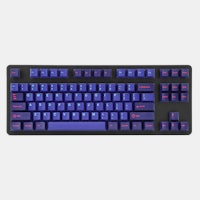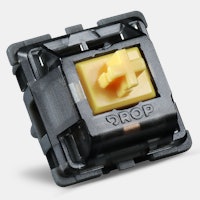Click to view our Accessibility Statement or contact us with accessibility-related questions









Keymap wizardry: Typing out the Harry Potter saga

search
close
Sort by: Newest
keyboard_arrow_down
Kenshiro70
137
Aug 2, 2024
In your next article with tips and tricks, could you list out keycap profiles which are most compatible with custom layouts? That tends to be one of the thornier issues when going off the beaten path.
Also, if there are ready-made tools which can automatically take exported text files of stuff I've written and produce an analysis, that would be great. I've seen prior articles which used python scripts, but I'm not sure most people would brave the vagaries of github just to get those results.

Kenshiro70
137
Aug 2, 2024
Great article! Would it be possible to put the scores into a spider graph? That might make it easier to visualize the differences you highlight and make comparisons between layouts a little more stark. Try two versions - one with absolute values and one with percentage gains versus QWERTY - and then you can decide which illustrates your points best.
(Edited)
PRODUCTS YOU MAY LIKE
Trending Posts in Mechanical Keyboards
The-Cindy
This is easily my new favorite keeb
The IDOBAO ID80 Crystal Gasket Keyboard Kit is a standout choice for mechanical keyboard enthusiasts seeking both aesthetics and performance. Its transparent acrylic case beautifully showcases the...
Dec 20, 2024
Squizzle
Keyboard & Drink
Shine-Through LOTR Keycaps Concept
Would anyone else be interested in a shine-through set of LOTR keycaps? Imagine a glowing black speech keycap set that seduces like the one ring. Perhaps the pale blue moonlight glow of the elven...
Dec 20, 2024
Akofena
Are shipments to Argentina safe?
I want to buy a keyboard with some keycaps ! but i live in argentina. ty
Dec 17, 2024

tbui
Absolutely stunning
The colors really pop on a white board. Easily one of the best caps I own!
Dec 17, 2024
bobbibeer1976
False Advertising BEWARE
This company should be ashamed of themselves. Advertising to young people who save all their money and want nothing more than a keyboard and advertise to them that it is in stock and will be shipped asap and they will arrive before Christmas. Only to "ship" and package and get their hopes up and it arrives and there is no keyboard in the package. Then to get on the website and it isn't even going to ship until January. This happens AFTER you have received their money and made promises that it was arriving, on it 's way, etc! Shame Shame on you!!!
Dec 16, 2024

EuclideanGambit
Closest profile to MT3
I really enjoy the MT3 profile, it has actually become kind of difficult to type on other profiles. So I was looking for some that might be close and noticed the SA profile. I was wondering if there were anymore that were close to it. This would open my options significantly when shopping around.
Dec 15, 2024

tbui
Displaying my DCD Lunar New Year set (Max)
Enough for a full base kit plus novelties, just gotta watch the ample space on top when moving/tilting and near the edges it gets tight so the caps don't fit in as smoothly.
Dec 15, 2024















Imagine you are an aspiring writer with a brilliant idea, just about to start typing out your magnum opus, staring at a yet empty document on your screen. Cursor blinking, annoying orphan relatives locked up in the cupboard under the stairs. Your story, about a young boy who ends up saving the world, is quite complete. You "just" have to type out heaps of your manuscripts and notes: about 6.5 million keystrokes.
How could we find better layouts? How to decide if one layout is better than the other? Many people do this intuitively, tweaking their keymaps perpetually, swapping some characters and checking the results. A more sophisticated approach is to use dedicated optimization tools (algorithms and models), which do the job in an automated way, handling a huge number of potential layouts to find the best one given the physical layout, corpus and ruleset. Regardless of the exact method used, the evaluation phase is similar to this:
Christopher Latham Sholes, inventor of QWERTY, did something similar when working on his typing machine back in the 1860-70s - counting letters and bigrams by hand, using pen and paper. August Dvorak and his team too. However, we are much luckier than our predecessors: thanks to our magical devices called computers we can compare thousands or millions of layouts in a realistic time-frame of mere minutes. That's how we can "type out" Harry Potter a few million times. (Sorry if you feel deceived.) Putting improvements into context (% to keypresses) So how to interpret the numbers above? What does a 1% or 0.1% (or 9 3/4) difference really mean? I found that it's easier to comprehend these values in the context of everyday metrics: keypress per page or line. E.g. the average line of text, with optimal readability in mind, is about 55-60 characters. We could agree on 50 characters for easy mental calculation, so roughly about 2% difference means one keypress less or more per line.
DNT Taking a look at the heatmap above, you may feel compelled to improve the layout by putting some frequent letters in the "right place". E.g. the layout I call DNT is the result of the most straightforward three letter swaps: D-E, N-J, T-F. (There are other obvious choices but they may introduce some unexpected effects.) All these letters stay on the same fingers so the layout is very easy to learn.
- Finger travel: 10.37 km → 5.46 km (-47.37%) Quite a start!
- Home row: 26.1% → 59.25% Nice!
- Min. samefinger: 3.89% → 0.25 Wow!
- Min. hurdle: 6.49% → 0.06% OMG!
- Max. rolls: 3.61% → 12.9% Yummy!
- (Max. inner rolls: 1.93% → 10.42%)
- Max. alternation: 52.87% → 70.07% If you fancy this.
(The numbers are based on a non-deterministic genetic model so they may be further improved. Slightly.) Too good to be true, right? 6-7 comfy rolls in a single line? Encountering a pesky hurdle only once per page? Not even leaving the home positions for 6 out of 10 keypresses? Sadly, since some indicators are antagonistic, achieving these numbers at once is impossible. Nevertheless, this may serve as a good reference when comparing our more realistic, aggregated layouts. Is it worth it? Based on the results above, I'd say changing to an alternative layout should be a no-brainer.Conclusion As this case study hopefully demonstrated: Alternative and custom layouts may dramatically improve your typing experience. Your typing habits are unique, average English doesn't really exist on the individual level, so there’s a chance that popular layouts are not the best option for you. All in all, feel free to experiment with alternative layouts or come up with your custom one. How exactly? Let's see some tips, exact steps (and warnings) next time.